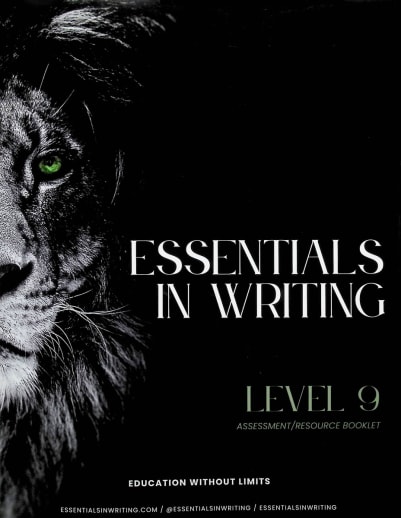This second edition Assessment/Resource Book provides three grammar assessments, five composition assessments, and two comprehensive unit tests. Also included are paragraph and composition resources, checklists, and multiple graphic organizers. 83+ pages. ~ Ruth
Essentials in Writing Level 9 Assessment/Resource Book 2nd Edition
Product Overview
- Tests over sentence-level and composition lessons, with 2 comprehensive assessments
- Writing helps and organizer tools included
- Does not correlate with first edition grade 9
- Checks student’s retention and understanding
Description
- Assessments
3 grammar assessments in a variety of formats (fill in the blank and revision activities associated with both sentences and larger compositions), five composition assessments, and two comprehensive unit tests - Resources
Paragraph and composition resources, checklists, and multiple graphic organizers
This second edition is a major update visually as well as in content. Integrating an appropriate, well-planned, and welcoming visual presentation, this new edition adds significant changes in content, updated writing samples, essay checklists, and more. While the general type of writing assignments (personal, expository, argumentative, compare/contrast, and research paper) has not changed from the first edition, the content and the order of the writing prompts have.
Students are ready for this course if they have mastered grade-level-appropriate sentences and written some compositions. The 91 video and text lessons are divided into units. Students start with familiarizing themselves with the writing process: choosing quality word choices and vivid language, building effective sentences, and handling common writing and grammatical problems. They’ll focus on fragments and common issues that arise when researching (paraphrasing, summarizing, and citing information). Then, the attention turns to audience and purpose. Students will first focus on the paragraph level (expository, argumentative, compare and contrast). After a quick review of essay writing, students will practice applying their skills in personal, expository, argumentative, and compare/contrast essay assignments. For each essay, the curriculum provides ineffective and effective student examples that provide helpful comparisons, which is so beneficial for an independent learner. Students practice developing their voice and applying it in a variety of writing modes. The final 15 lessons help students systematically write and then culminate the research project with an oral presentation. Students end the course by evaluating their writing skills.
To teach one student, you’ll need to purchase either the Bundle (which includes the student book, the teacher handbook, digital student and teacher materials, and the online video instruction) or the Bundle with Assessment (which adds a physical and digital assessment/resource book). If you wish to test your student’s skills, this consumable Assessment/Resource is available separately and provides 8 assessments on word choice, sentence structure, common problems, and each essay type. This resource also provides writing organizers, writing checklists, and a complete answer key. The bundles also include a 44-page Teacher Handbook that provides brief instructions for grading essays; a checklist for each writing assignment; and 100-point rubrics to help students (and parents) evaluate writing assignments both at the sentence level (such as transitions, word choice, mechanics, and thesis) and at the essay level (such as thesis, opening and closing paragraphs, and citations). A limited number of fee-based scoring services are available directly from the publisher. Each student taking the course will need a consumable student book. To build a complete language arts program, combine this course with your choice of a literature course, or select EIW’s literature and composition combination. ~ Ruth
| Product Format: | Paperback |
|---|---|
| Grade: | 9 |
| Brand: | Essentials in Writing |
| ISBN: | 9781960831262 |
| Length in Inches: | 11 |
| Width in Inches: | 8.5 |
| Height in Inches: | 0.25 |
| Weight in Pounds: | 0.6 |

